Comparison of Precipitates and Texture Evolution in Nb-Bearing Grain-Oriented Silicon Steel Produced by Conventional Processing and Novel Twin-Roll Casting
Abstract
1. Introduction
2. Experimental Procedures
3. Results and Discussions
3.1. The Conventional Hot Rolled Strip and Twin-Roll As-Cast Strip
3.2. The Primary Annealed Sheets
3.3. The Secondary Annealed Sheets
4. Conclusions
- The type of precipitates in conventional and twin-roll casting processing routes was different. In the conventional processing route, the mainly precipitates were NbN. However, in the twin-roll casting processing route, the precipitates of NbN were inhibited during the rapid solidification, and a new type precipitate of NbS was obtained.
- In the twin-roll casting processing route, the Goss texture of grain-oriented silicon steel was formed during the cold rolling and primary annealing steps, which are totally different from that which originated from the hot rolling stage in the conventional processing route. Furthermore, the area fraction of primary recrystallized Goss texture in twin roll casting specimens was higher than that of conventional specimens.
- The magnetic properties of twin-roll casting grain-oriented silicon steel were better than that of conventional grain-oriented silicon steel. The relatively good magnetic properties can be attributed to the strong {111} <112> primary recrystallized texture in twin-roll casting specimens rather than {111} <110> texture in conventional specimens.
Author Contributions
Funding
Conflicts of Interest
References
- Moses, A.J. Energy efficient electrical steels: Magnetic performance prediction and optimization. Scr. Mater. 2012, 67, 560–565. [Google Scholar] [CrossRef]
- Park, H.-K.; Han, C.-H.; Park, C.-S.; Park, J.-T.; Joo, H.-D. Abnormal grain growth induced by grain boundary segregation of yttrium in grain-oriented Fe-3%Si steel. Mater. Charact. 2018, 146, 204–208. [Google Scholar] [CrossRef]
- Matsuo, M. Texture control in the production of grain oriented silicon steels. ISIJ Int. 1989, 29, 809–827. [Google Scholar] [CrossRef]
- Xia, Z.; Kang, Y.; Wang, Q. Developments in the production of grain-oriented electrical steel. J. Magn. Magn. Mater. 2008, 320, 3229–3233. [Google Scholar] [CrossRef]
- Mishra, S.; Kumar, V. Co-precipitation of copper-manganese sulphide in Fe-3%Si steel. Mater. Sci. Eng. B 1995, 32, 177–184. [Google Scholar] [CrossRef]
- Liao, C.-C.; Hou, C.-K. Effect of nitriding time on secondary recrystallization behaviors and magnetic properties of grain-oriented electrical steel. J. Magn. Magn. Mater. 2010, 322, 434–442. [Google Scholar] [CrossRef]
- Wang, Y.; Xu, Y.; Zhang, Y.-X.; Fang, F.; Lu, X.; Liu, H.-T.; Wang, G.-D. Development of microstructure and texture in strip casting grain oriented silicon steel. J. Magn. Magn. Mater. 2015, 379, 161–166. [Google Scholar] [CrossRef]
- Song, H.-Y.; Liu, H.-T.; Lu, H.-H.; An, L.-Z.; Zhang, B.-G.; Liu, W.-Q.; Cao, G.-M.; Cheng-Gang, L.; Liu, Z.-Y.; Wang, G. Fabrication of grain-oriented silicon steel by a novel way: Strip casting process. Mater. Lett. 2014, 137, 475–478. [Google Scholar] [CrossRef]
- Park, J.Y.; Oh, K.H.; Ra, H.Y. Texture and deformation behavior through thickness direction in strip-cast 4.5wt%Si steel sheet. ISIJ Int. 2000, 40, 1210–1215. [Google Scholar] [CrossRef]
- Park, J.Y.; Oh, K.H.; Ra, H.Y. The effects of superheating on texture and microstructure of Fe-4.5wt%Si steel strip by twin-roll strip casting. ISIJ Int. 2001, 41, 70–75. [Google Scholar] [CrossRef]
- Lu, X.; Xu, Y.; Fang, F.; Zhang, Y.-X.; Wang, Y.; Jiao, H.; Cao, G.-M.; Li, C.-G.; Yuan, G.; Wang, G.-D. Microstructure, texture and precipitate of grain-oriented 4.5wt% Si steel by strip casting. J. Magn. Magn. Mater. 2016, 404, 230–237. [Google Scholar] [CrossRef]
- Dorin, T.; Wood, K.; Taylor, A.; Hodgson, P.; Stanford, N. Quantitative examination of carbide and sulphide precipitates in chemically complex steels processed by direct strip casting. Mater. Charact. 2016, 112, 259–268. [Google Scholar] [CrossRef]
- Malekjani, S.; Timokhina, I.B.; Wang, J.; Hodgson, P.D.; Stanford, N. Static recrystallization of strip cast alloys in the presence of complex nano-sulfide and nitride precipitates. Mater. Sci. Eng. A 2013, 581, 39–47. [Google Scholar] [CrossRef]
- Wang, Y.; Xu, Y.; Zhang, Y.-X.; Fang, F.; Lu, X.; Misra, R.; Wang, G.-D. Effect of annealing after strip casting on texture development in grain oriented silicon steel produced by twin roll casting. Mater. Charact. 2015, 107, 79–84. [Google Scholar] [CrossRef]
- Wang, Y.; Zhang, Y.-X.; Lu, X.; Fang, F.; Xu, Y.; Cao, G.-M.; Li, C.-G.; Misra, R.; Wang, G.-D. A novel ultra-low carbon grain oriented silicon steel produced by twin-roll strip casting. J. Magn. Magn. Mater. 2016, 419, 225–232. [Google Scholar] [CrossRef]
- Hou, R.; Zhu, C.; Li, G.; Zhou, B.; Jia, J. Effect of Niobium on Precipitates and Texture Evolution of Fe-3% Si Grain-oriented Electrical Steel Annealed Hot Band. ISIJ Int. 2017, 57, 2245–2254. [Google Scholar] [CrossRef]
- Hulka, K.; Vlad, C.; Doniga, A. The role of niobium as microalloying element in electrical sheet. Steel Res. 2002, 73, 453–460. [Google Scholar] [CrossRef]
- Fang, F.; Lan, M.-F.; Lu, X.; Zhang, Y.X.; Wang, Y.; Yuan, G.; Cao, G.; Xu, Y.; Misra, R.; Wang, G. The impact of niobium on the microstructure, texture and magnetic properties of strip-cast grain oriented silicon steel. J. Magn. Magn. Mater. 2017, 442, 1–7. [Google Scholar] [CrossRef]
- Feng, Y.-L.; Guo, J.; Li, J.; Ning, J. Effect of Nb on solution and precipitation of inhibitors in grain-oriented silicon steel. J. Magn. Magn. Mater. 2017, 426, 89–94. [Google Scholar] [CrossRef]
- Lu, X.; Fang, F.; Zhang, Y.; Wang, Y.; Yuan, G.; Xu, Y.; Cao, G.; Misra, R.; Wang, G. Evolution of microstructure and texture in grain-oriented 6.5%Si steel processed by strip-casting. Mater. Charact. 2017, 126, 125–134. [Google Scholar] [CrossRef]
- Wang, Y.; Fang, F.; Lu, X.; Zhang, Y.; Xu, Y.; Cao, G.; Li, C.; Misra, R.D.K.; Wang, G.-D. A Comparative Study of Microstructure and Texture Evolution in Cu-Bearing and Nb-Bearing Grain Oriented Silicon Steels. Steel Res. Int. 2016, 88, 1600181. [Google Scholar] [CrossRef]
- Shimizu, Y.; Ito, Y.; Iida, Y. Formation of the Goss orientation near the surface of 3 pct silicon steel during hot rolling. Met. Mater. Trans. A 1986, 17, 1323–1334. [Google Scholar] [CrossRef]
- Wang, P.; Liu, J.; Qi, Q.; Chang, X.; Gao, S.; Zhang, W.; Wang, P. Precipitate formations with self-adaptive elemental diffusion and segregation in T92 steel. J. Alloy. Compd. 2017, 693, 264–278. [Google Scholar] [CrossRef]
- Park, J.-T.; Szpunar, J. Evolution of recrystallization texture in nonoriented electrical steels. Acta Mater. 2003, 51, 3037–3051. [Google Scholar] [CrossRef]
- Park, N.-J.; Joo, H.-D.; Park, J.-T. Evolution of Goss Orientation during Thermal Heating with Different Heating Rate for Primary Recrystallization in Grain-oriented Electrical Steel. ISIJ Int. 2013, 53, 125–130. [Google Scholar] [CrossRef][Green Version]
- Homma, H.; Hutchinson, B. Orientation dependence of secondary recrystallisation in silicon–iron. Acta Mater. 2003, 51, 3795–3805. [Google Scholar] [CrossRef]
- Eloot, K.; Okuda, K.; Sakata, K.; Obara, T. Texture evolution during cold rolling and recrystallisation of IF steel with a strong {111} hot band texture. ISIJ Int. 1998, 38, 602–609. [Google Scholar] [CrossRef]
- Ray, R.K.; Jonas, J.J.; Hook, R.E. Cold rolling and annealing textures in low carbon and extra low carbon steels. Metall. Rev. 1994, 39, 129–172. [Google Scholar] [CrossRef]
- Jonas, J. Effects of shear band formation on texture development in warm-rolled IF steels. J. Mater. Process. Technol. 2001, 117, 293–299. [Google Scholar] [CrossRef]
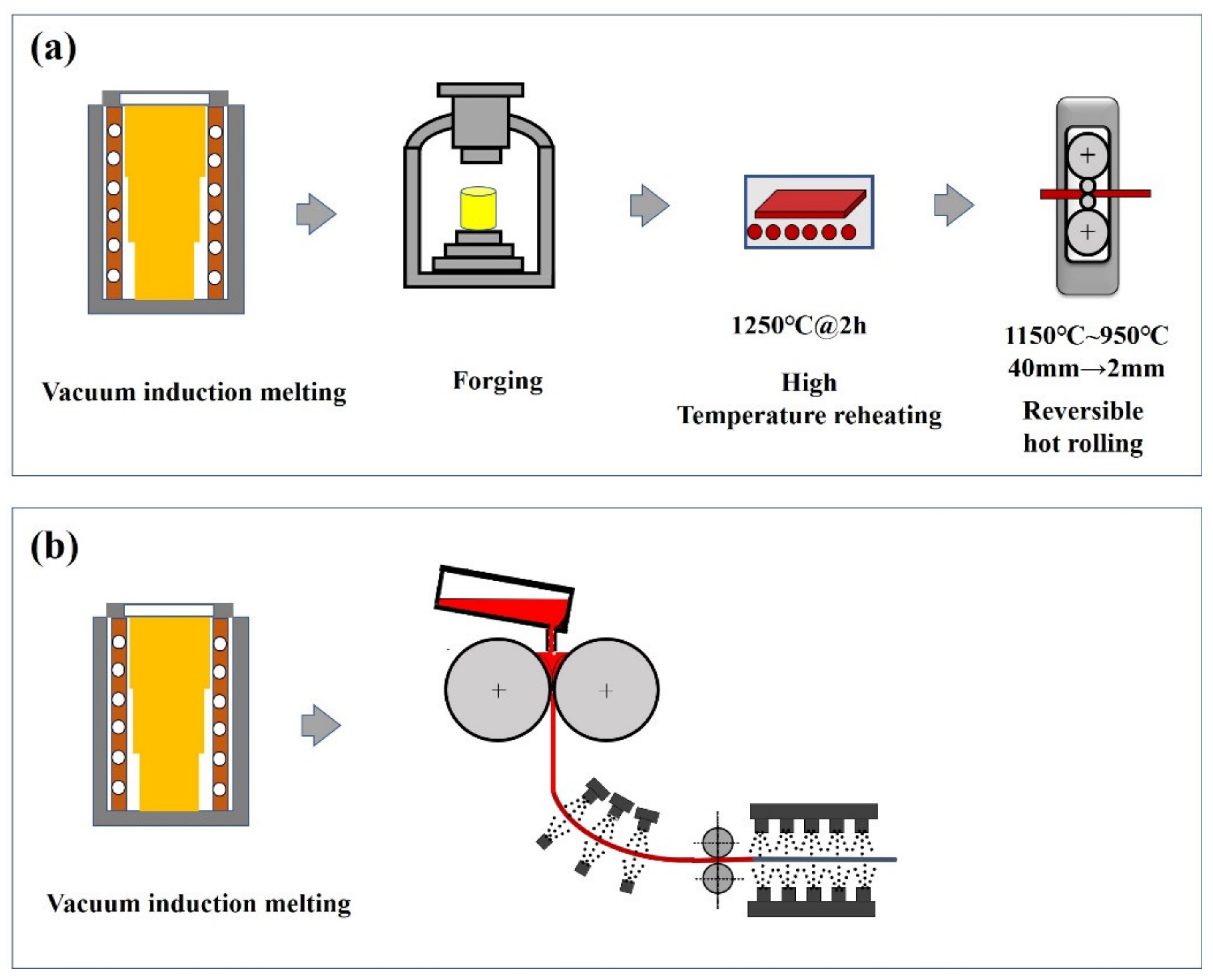

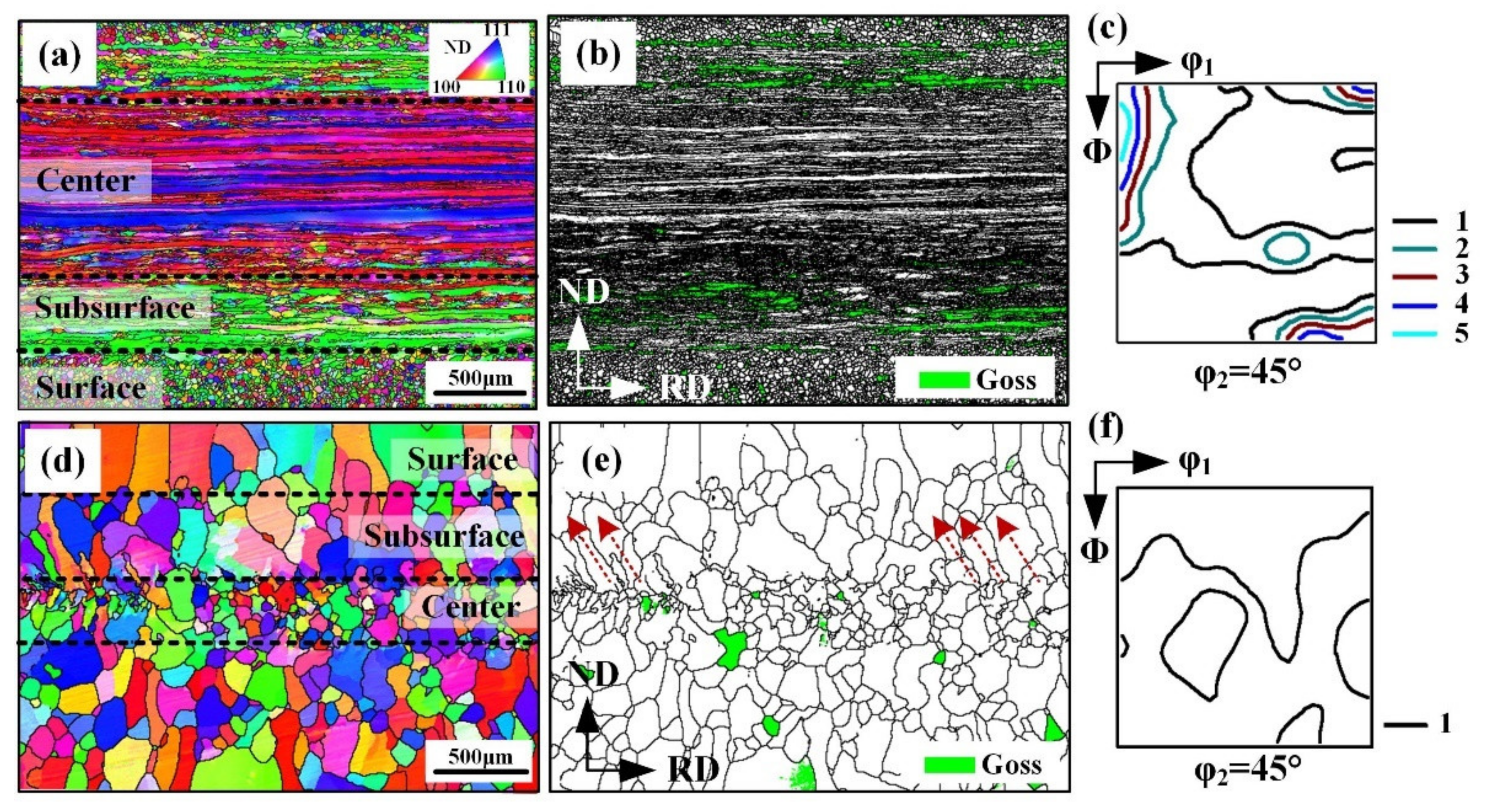
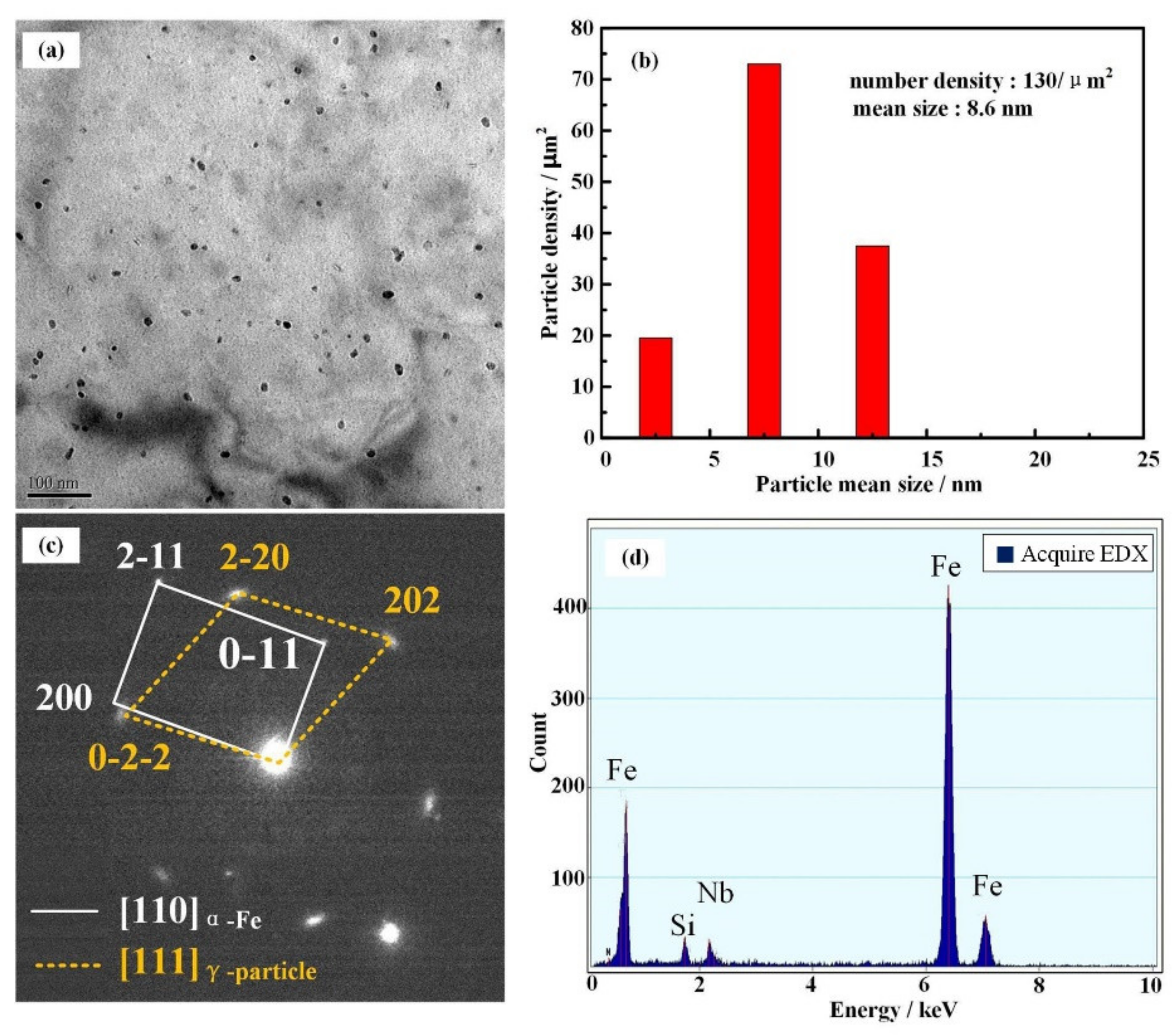
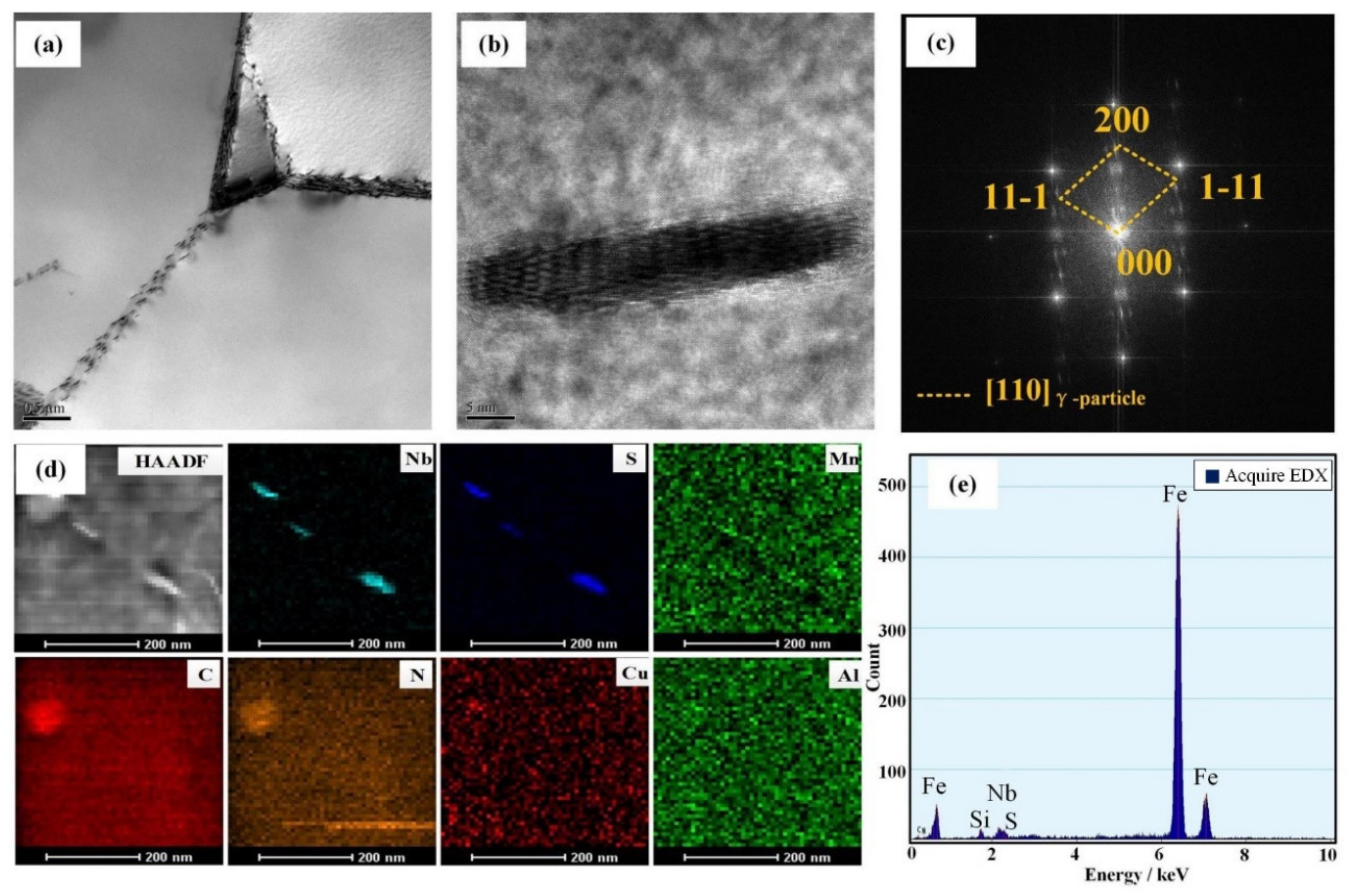
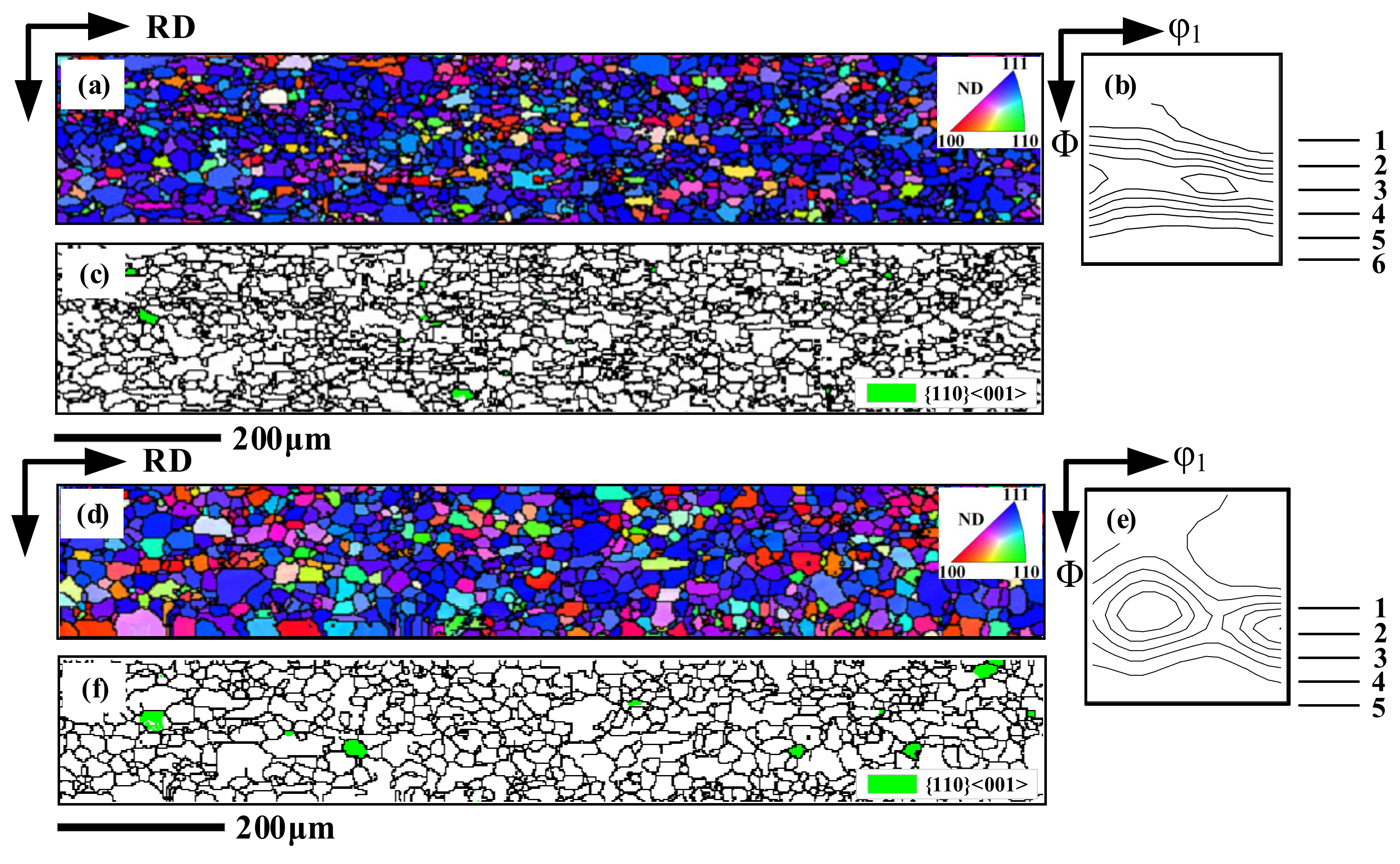
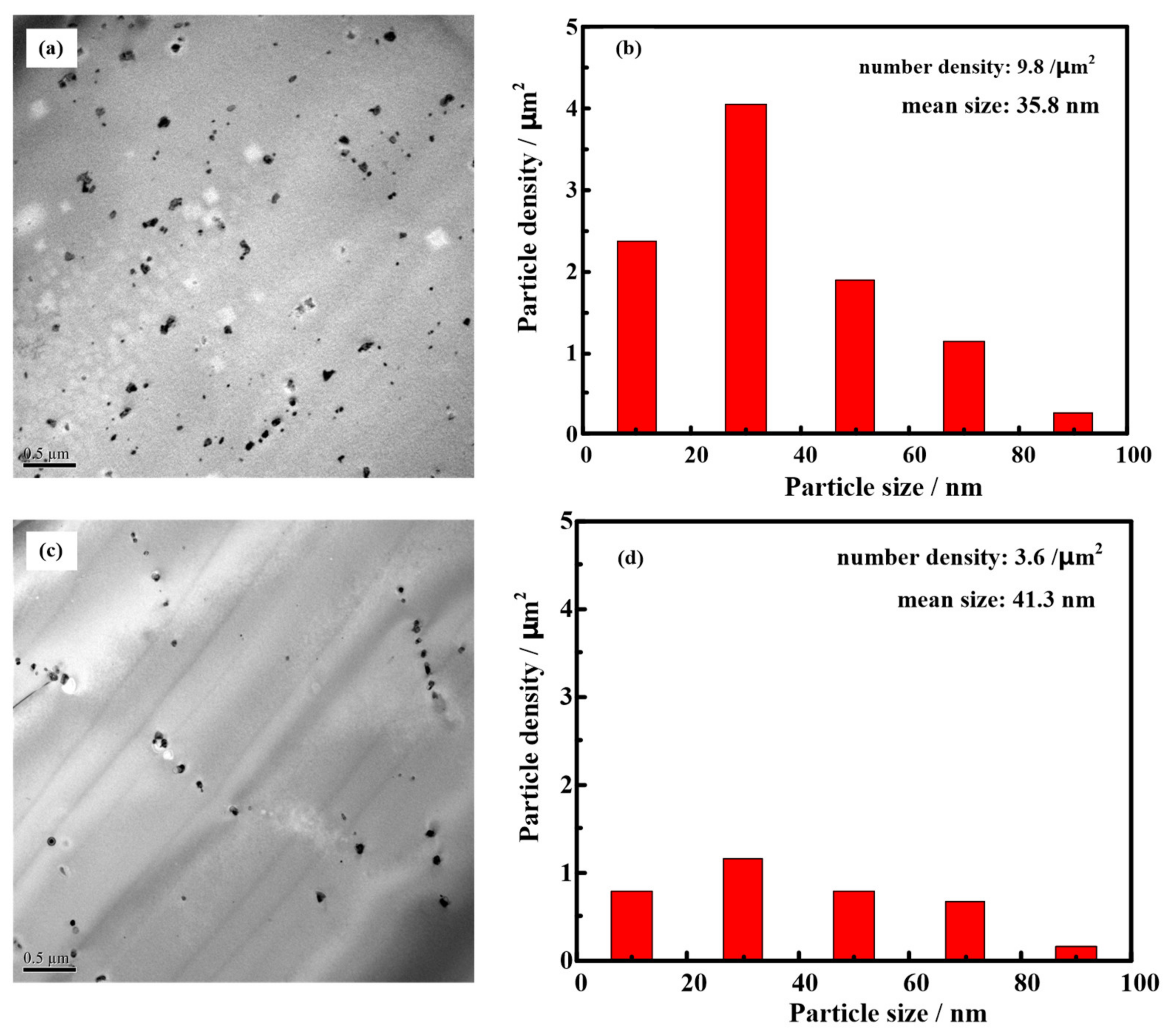
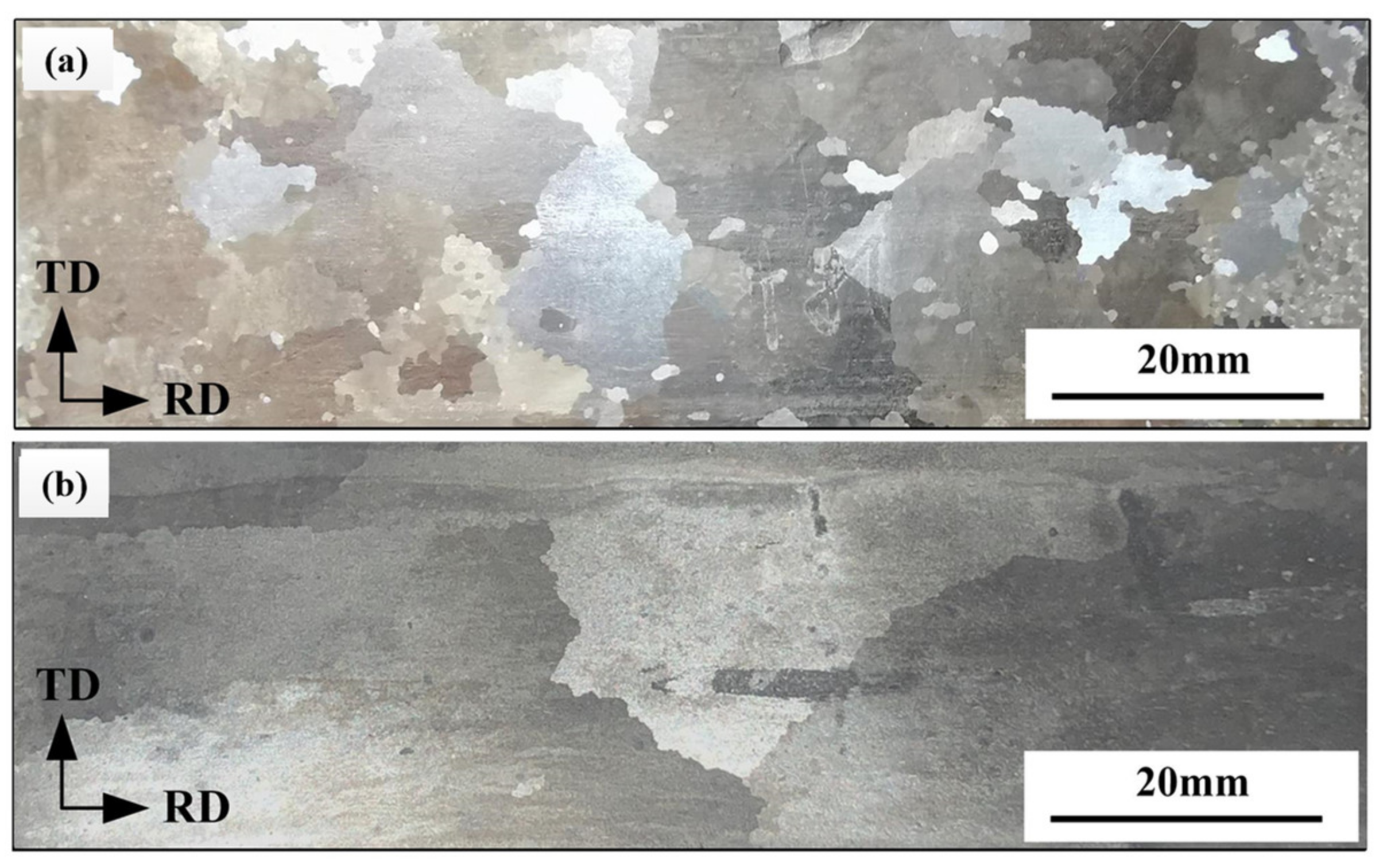
| Process & Elements | C | Si | Mn | Al | S | N | Nb |
|---|---|---|---|---|---|---|---|
| Twin roll casting process | 0.005 | 3.05 | 0.08 | 0.013 | 0.021 | 0.008 | 0.061 |
| Conventional process | 0.005 | 3.18 | 0.085 | 0.010 | 0.020 | 0.005 | 0.060 |
© 2020 by the authors. Licensee MDPI, Basel, Switzerland. This article is an open access article distributed under the terms and conditions of the Creative Commons Attribution (CC BY) license (http://creativecommons.org/licenses/by/4.0/).
Share and Cite
Wang, Y.; Zhang, Y.; Fang, F.; Lu, X.; Yuan, G.; Wang, G. Comparison of Precipitates and Texture Evolution in Nb-Bearing Grain-Oriented Silicon Steel Produced by Conventional Processing and Novel Twin-Roll Casting. Metals 2020, 10, 1085. https://doi.org/10.3390/met10081085
Wang Y, Zhang Y, Fang F, Lu X, Yuan G, Wang G. Comparison of Precipitates and Texture Evolution in Nb-Bearing Grain-Oriented Silicon Steel Produced by Conventional Processing and Novel Twin-Roll Casting. Metals. 2020; 10(8):1085. https://doi.org/10.3390/met10081085
Chicago/Turabian StyleWang, Yang, Yuanxiang Zhang, Feng Fang, Xiang Lu, Guo Yuan, and Guodong Wang. 2020. "Comparison of Precipitates and Texture Evolution in Nb-Bearing Grain-Oriented Silicon Steel Produced by Conventional Processing and Novel Twin-Roll Casting" Metals 10, no. 8: 1085. https://doi.org/10.3390/met10081085
APA StyleWang, Y., Zhang, Y., Fang, F., Lu, X., Yuan, G., & Wang, G. (2020). Comparison of Precipitates and Texture Evolution in Nb-Bearing Grain-Oriented Silicon Steel Produced by Conventional Processing and Novel Twin-Roll Casting. Metals, 10(8), 1085. https://doi.org/10.3390/met10081085




